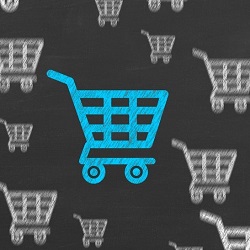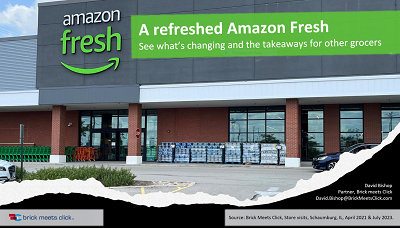Competing with online grocery retailers: Five ways grocers can win more sales
Complete the form below to instantly download this month's dashboard.

The growth ofonline grocery shopping options that are vying for shoppers attention andspending has many grocers worried about competition from online grocery providers.
The key to competing in this landscape full of new players is to have a framework forunderstanding what’s happening – and then understanding what you can do to winmore omnichannel sales by leveraging the strengthens of your stores, your proximity to shoppers, and the growing influence of digital on in-store purchases.
Here's a look at how digital is impacting shopping trips, a realistic assessment of online grocery's share of wallet, and five things that traditional brick and mortar grocers should focus on to better meet their shoppers' needs.
What's happening
Digitally-enabledtrip missions

Trip missions are the concept that the same shopper will havedifferent reasons and therefore different types of shopping trips on any givenday depending on what is going on in their lives. The arrival of online grocery shopping anddigital tools has caused trip missions to evolve and expand into new territory.
Here are six that have clearly been impacted by digital.
- Shop when I want/can
- Stick to my budget
- Take my order
- Need it "just in time"
- Help me host
- Help me find better options
These trip missions are being served by new groceryeCommerce players like Boxed, Blue Apron, Jet.com and the expansion of otherplayers such as Amazon – but they can most certainly be served by moretraditional grocers who are willing to adjust and refine their strategies.
Changing expectations
Shopperexpectations have changed for good because of digital resources. Today shoppers– including grocery shoppers – expect to be able to shop when they want to andhow they want to. To be competitive, you need to offer your customers blendedphysical and digital options that fit their lives and meet their needs (hencethose trip missions listed above). If you don’t, they’ll go elsewhere.
NOW FOR THE GOOD NEWS: If you are grocery retailer, customers want to shop with you online!At Amazon.com and its subsidiaries,shoppers place an average of 1.5 online grocery orders per month with anaverage basket size of $42 ($63 per month). In contrast, supermarket customersplace 2.2 online grocery orders per month at an average basket size of $128 ($281per month).
Being a trusted, familiar grocery retailer is a major advantage,and supermarkets can and should work hard to preserve this advantage in theface of increasing competition from Amazon and other online-only retailers. Actingnow to develop your omnichannel sales offering is critical because competitionwill only become more intense as online providers look to increase theirphysical footprint to improve their omnichannel offering.
What retailers can to do compete better
Traditionally,brick and mortar grocery retailers have tended to think about online vs.in-store grocery shopping as an either/or proposition with separate salesstreams, but the two are deeply connected. Recognizing the value of thisconnection – and using it to win more sales – is key to competing in today’sintegrated retail environment.
Here are fiveways grocers can leverage the connection between digital and physical retail.
#1 Increase share of mind by maximizing your digital connections.
Digitalconnections with customers impact your entire store sales, not just your onlinesales. When we analyzed the impact of the six primary digital connections onshoppers – email, websites, texting, social networks, mobile apps, and onlineshopping – we learned two important things.
- First, the more digital connections acustomer had with the store, the greater their satisfaction with the store.
- Second, the more digital connections theshopper had with the store, the more likely they were to be among the store’score primary shoppers.

One of thebest things you can do to win more sales is to maximize your digitalconnections by pushing out relevant information – information that makesshopping easier – through these six platforms.
#2 Improve seamless shopping - it’s not just for the big guys.
Theinvestments that Kroger, Walmart, and Target are making in improving theirmobile apps and other technologies has attracted a lot of attention, but they don’town the market on delivering a seamless experience. Several regional andsmaller operators are offering great experiences.
The ease ofshopping is hugely important to today’s time-stressed grocery customers who aredeciding between time with their family and going to the supermarket. Theeasier and quicker you make it for them to shop – both in-store and online –the better you’ll be able to compete. Anything you can do to reduce frictionpoints for shoppers will help you win customers.
Recognizethat shoppers use online or mobile tools even when they intend to shop instore. How’s your search? Can your shoppers easily find the following onlinewhile they are in your store?
- relevant product information
- information on out of stocks
- the aisle location of items
#3 Give shoppers options for getting their online orders.
This means offeringpickup and delivery for online orders. Some customers prefer delivery whileothers prefer pickup. Retailers won’t be serving their entire addressablemarket if they offer just one option. The good news is that pickup costs retailers less to provide, maintainsthe personal relationship with customers, and allows customers to also shopin-store when they come for a pickup.
#4 Differentiate your in-store experience.
This is all about making sure youmaximize the advantage of the store and your physical proximity to shoppers.
UP YOUR LEVEL OF CUSTOMER SERVICE . Storeassociates are one of the supermarket’s most underutilized assets – and one ofthe biggest advantages that supermarkets have over digital-only retailers.Train your staff on both product knowledge and the store’s digital tools sothey become store ambassadors, and incent/reward them to help shoppersunderstand and use those tools. It’s one of the best investments you can makein building customer loyalty and trust and maximizing the return on yourinvestment in digital tools.
LOCAL PRODUCTS & DISCOVERY . Offering aunique assortment of local and/or niche products – and merchandising them in-storewith both traditional and technology-enhanced techniques that deliver informationlike that found online. Use these techniques/tactics to highlight specific tripmissions – like “help me find what I’m looking for” or “help me discover a newproduct that I might try.”
EXCEL IN PERISHABLES . The numberone driver for store visits is the meat department, followed closely by theproduce department. Supermarkets thrive in these areas. Use this advantage –and make sure your online orders deliver the same quality product that yourstore does. This is where online-only providers have traditionally struggled tomeet shopper expectations.
#5 Scale for profitable growth.
There’s nogetting around the fact that online grocery costs more than in-store grocery,so profitability is challenging. The key is to focus on the customer (notchannel) profitability.
Your mostprofitable customers will likely use both – and growing your base of profitableshoppers will produce far more gains over the long term than focusing on thechannel only. This means focusing on
- Acquisition
- Retention
- Basket size
This involvesdeveloping a solid understanding of your baseline operating cost and then identifyingand implementing systematic improvements.
Bottom Line
We expect that online grocery will continue to grow, and this makes interegrated retail even more critical for traditional brick and mortat retail operators, but one approach won’t fit all.
Each retailer and supplier needs to find andmaximize their advantage, and develop a strategy defined by market factors and basedon growing their most profitable customers.
This is where leveraging outside perspectives and expertise can speed up the process and help evaluate better alternatives. Digital is causing the current wave of disruption in grocery. Traditional retailers can and will survive, but the landscape will look very different five years out.
Related Posts
> Walmart's $11 billion store investments will help win the battle, but what about the war? (blog)
> Brick and mortar tries a new strategy: Accepting returns for other retailers and brands
> Kroger's EmporiYum: Investing to make private label products destination drivers
> What will the grocery business look like in 5 years? (blog)
Brick Meets Click is a strategic advisory firm with unparalleledexperience, expertise, and perspective on changes challenging the retail grocery industry. We work with organizations to create and evaluatethe right path forward to growth in today’s integrated physical/digital ecosystem. Learn more about our services .












